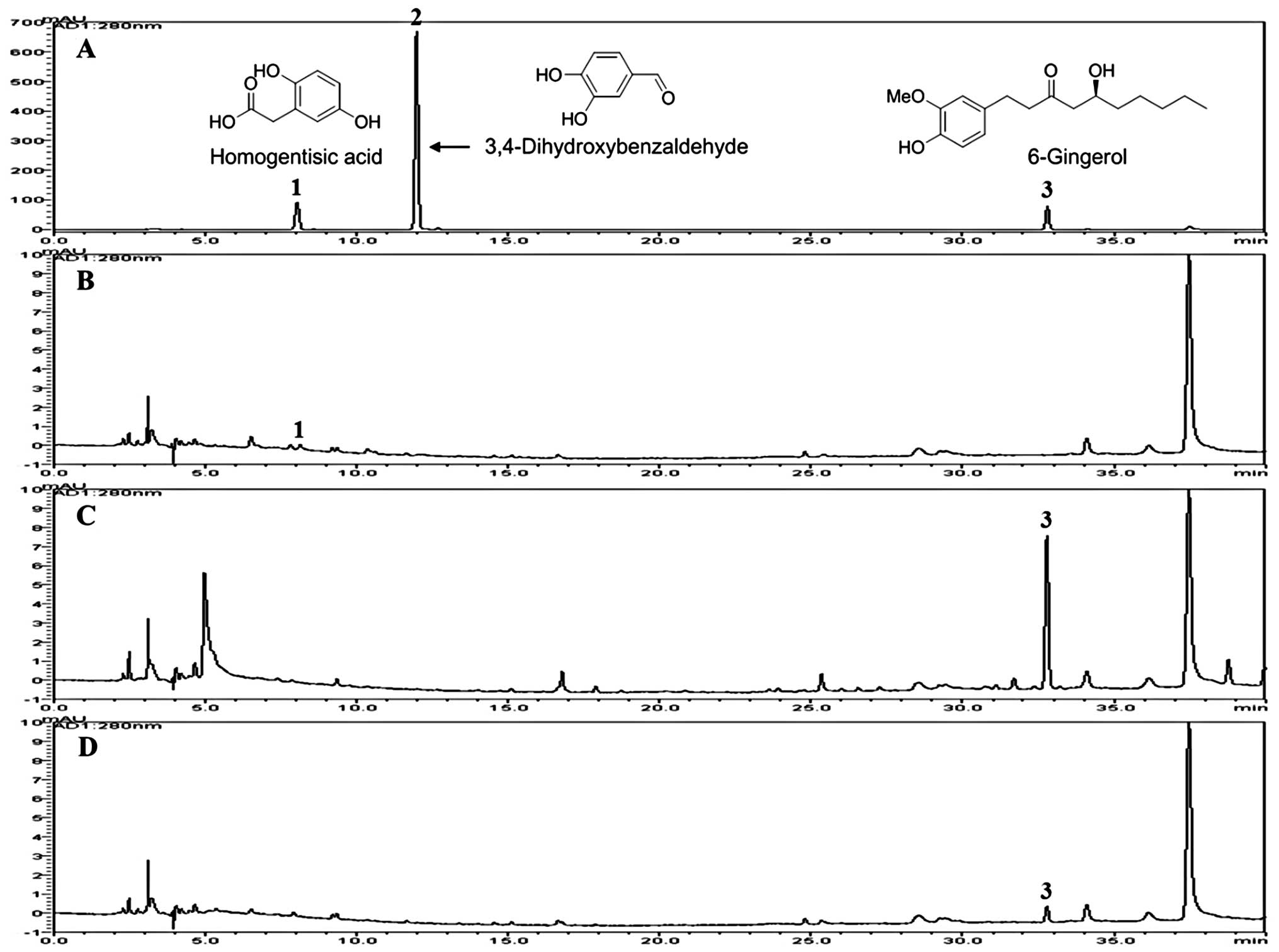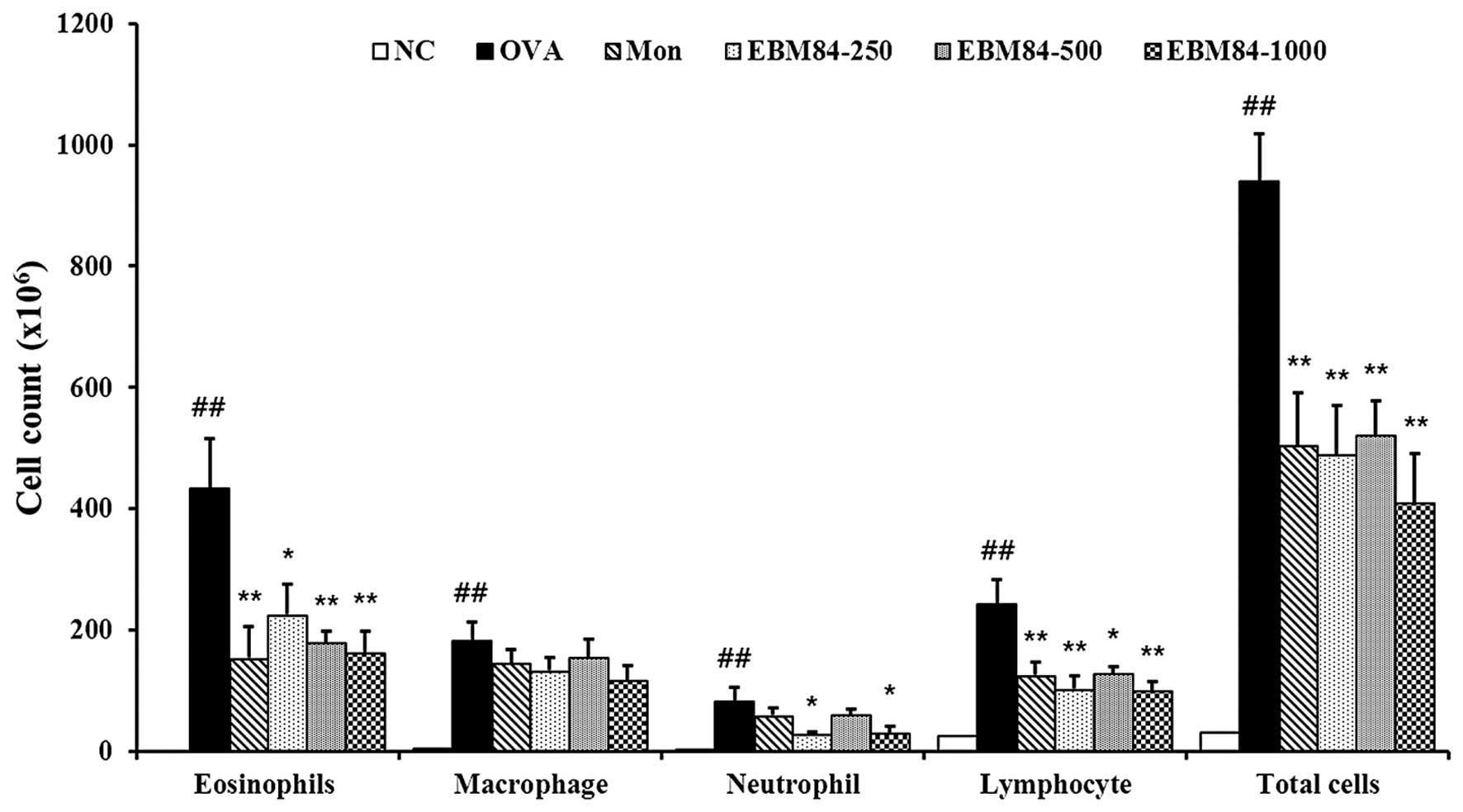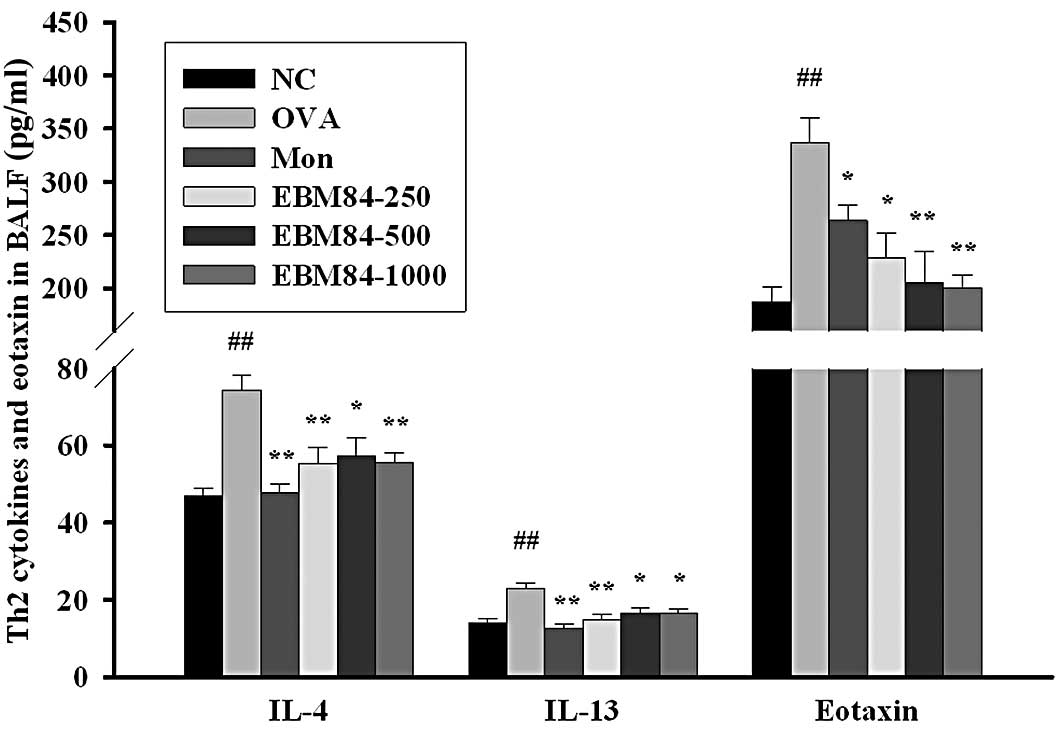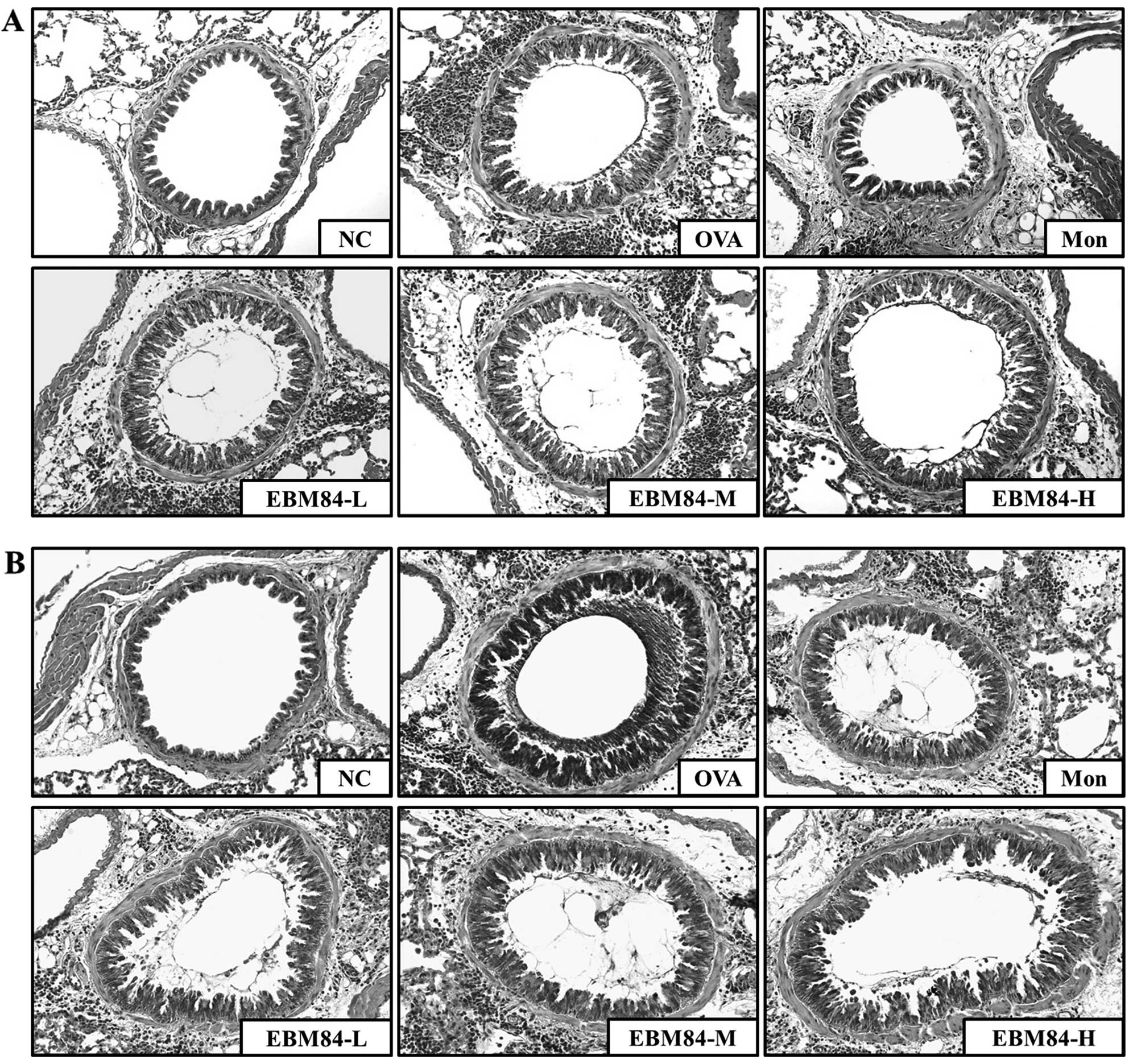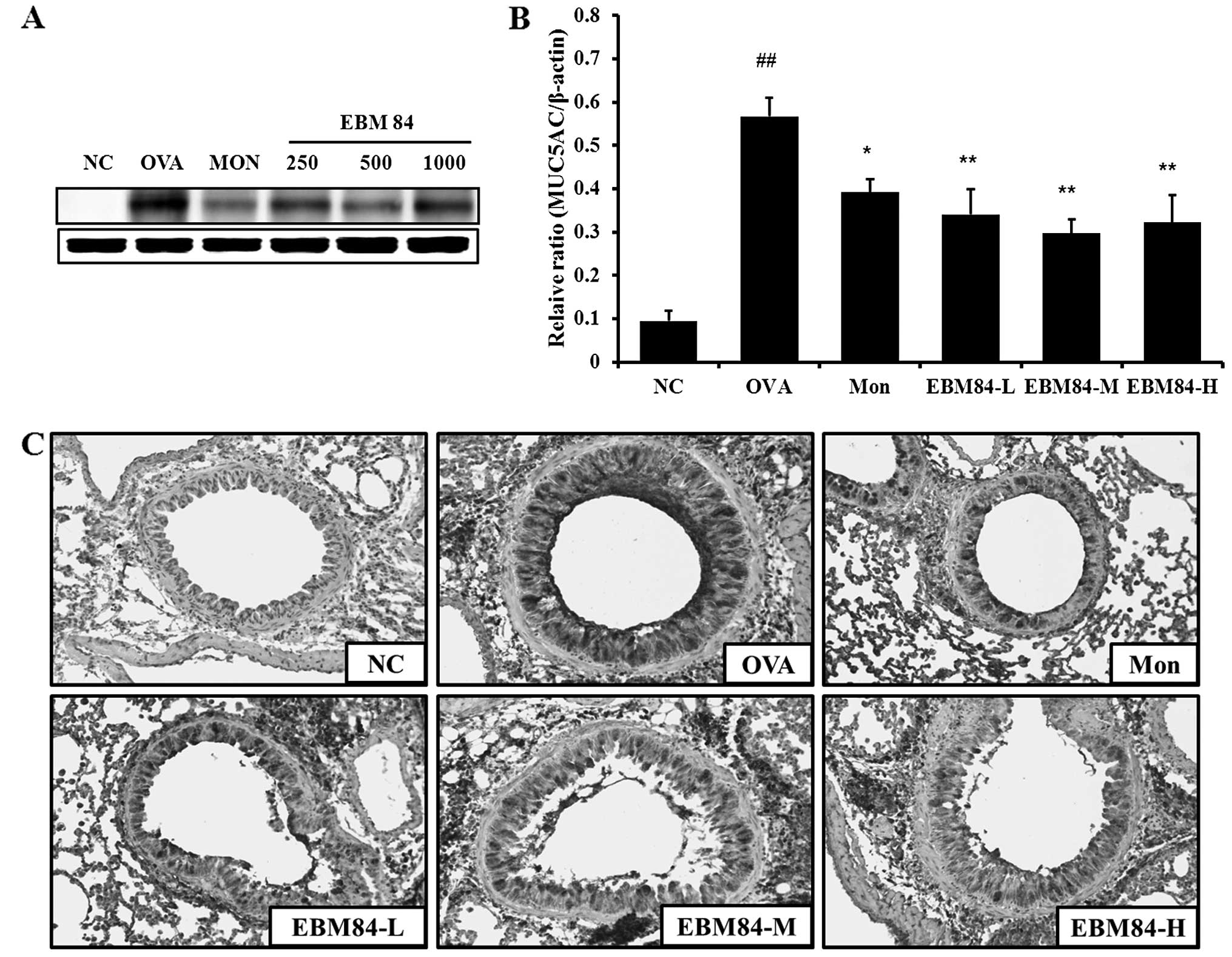EBM84 attenuates airway inflammation and mucus hypersecretion in an ovalbumin-induced murine model of asthma
- Authors:
- Published online on: February 6, 2013 https://doi.org/10.3892/ijmm.2013.1273
- Pages: 982-988
Abstract
Introduction
Allergic asthma is an increasingly important disease that develops following exposure to allergens and environmental factors, such as house dust, animal dander, pollen, smoking and volatile organic compounds (1,2). Allergic asthma involves eosinophil-rich inflammatory responses and mucus hypersecretion. Allergen exposure activates T helper 2 (Th2) cells to release Th2 cytokines, such as interleukin (IL)-4, IL-5, and IL-13 (3). These mediators increase inflammatory cell infiltration of the airway, immunoglobulin (Ig)E switching, and chemokine release, which lead to mucus hypersecretion in the bronchiolar epithelial region (4). Thus, Th2 cytokine reduction is the objective of antiasthmatic agents, including herbal medicines (3,5,6).
In the respiratory tract, the airway epithelium provides protection against various environmental irritants. The normal airway epithelium is coated with a mucus layer. Mucins are major components of the mucus layer and they are synthesized by epithelial goblet cells and the mucous cells of the submucosal glands (7). Mucin 5AC (MUC5AC) is reported to constitute 95–98% of the mucin secreted in the airway (8). MUC5AC is one of the main mucin genes expressed mostly in the respiratory epithelium and is related to mucus secretion (9). The mucin encoded by MUC5AC plays a role in host defense; however, it is likely that it causes airway obstruction if secreted in excess, since mucus containing a high concentration of MUC5AC has a high viscosity (8). MUC5AC production is regulated by Th2 cytokines, particularly IL-13. Konoh et al (10) demonstrated that IL-13 induced goblet cell hyperplasia and mucin hypersecretion via the overexpression of MUC5AC.
EBM84 is a traditional herbal medicine that contains Pinellia ternata (P. ternata) and Zingiber officinale (Z. officinale). Traditionally, it is used to treat vomiting, nausea, sputum and gastrointestinal disorders, such as dyspepsia and gastric ulceration. EBM84 is used as an expectorant. The pharmacological effects of P. ternata and Z. officinale have been demonstrated in a number of studies. P. ternata has antitussive, antiemetic and anti-inflammatory properties, while Z. officinale has been shown to exert antioxidant, anti-inflammatory and antitumor effects (11–13). Previous studies have also shown that that P. ternata and Z. officinale attenuate the asthmatic response induced by various allergens (14,15). However, it is known that P. ternata has a toxic effect since it is an irritant. In oriental medicine, the toxicity of P. ternata is reduced by combining it in a mixture with Z. officinale prior to its clinical application (16). The pharmacological effects of the component herbs found in EBM84 have been investigated extensively; however, studies on the pharmacological effects of EBM84 using in vivo or in vitro experiments are limited. Thus, in this study, we investigated the effects of EBM84 on airway inflammation and mucus secretion using an ovalbumin (OVA)-induced murine model of asthma. To the best of our knowledge, this is the first study to describe the protective effects of EBM84 against OVA-induced asthma.
Materials and methods
Chromatographic system
A Shimadzu LC-20A high-performance liquid chromatography (HPLC) system (Shimadzu Co., Kyoto, Japan) was used, which comprised a solvent delivery unit, an on-line degasser, a column oven, an autosampler and a photodiode array (PDA) detector. The data processor used LC solution software (version 1.24; Shimadzu Co.). Separations were performed using a Gemini C18 column (250×4.6 mm; particle size, 5 μm; Phenomenex, Torrance, CA, USA), which was maintained at 40°C. The mobile phases used for chromatographic separation were solvent A (1.0% v/v aqueous acetic acid) and solvent B (acetonitrile with 1.0% v/v acetic acid). Gradient elution was conducted as follows: (A)/(B) = 95/5 (0 min) → (A)/(B) = 25/75 (40 min) → (A)/(B) = 0/100 (45 min; hold for 5 min) → (A)/(B) = 95/5 (55 min; hold for 15 min). The analysis was performed at a flow-rate of 1.0 ml/min using a detection wavelength of 280 nm. The injection volume was 10 μl.
Reagents and materials
Homogentisic acid and 3,4-dihydroxybenzaldehyde were purchased from Sigma-Aldrich (St. Louis, MO, USA) and 6-gingerol was obtained from Wako (Osaka, Japan). The purity of the reference standard was ≥98.0% according to HPLC. HPLC-grade methanol, acetonitrile and water were obtained from J.T. Baker Chemical Co. (Phillipsburg, NJ, USA). Analytical reagent grade glacial acetic acid was purchased from Junsei Chemical Co., Ltd. (Tokyo, Japan). The raw materials, P. ternata Breitenbach and Z. officinale Roscoe, were purchased in July, 2011 from Kwangmyungdang Medicinal Herbs (Ulsan, Korea). The origin of the material was confirmed taxonomically by Professor Je-Hyun Lee, Dongguk University, Gyeongju, Korea. The voucher specimens (2011-EBM82 and 2011-EBM83) were deposited at the Basic Herbal Medicine Research Group, Korea Institute of Oriental Medicine, Daejeon, Korea.
Extraction
A mixture of dried P. ternata Breitenbach (50 g) and Z. officinale Roscoe (50 g) was extracted once in 1 l of distilled water with refluxing for 2 h. The extracted solution was filtered through filter paper, evaporated to dryness and freeze-dried (14.81 g). The yield of the water extract was 14.81%.
Preparation of standard and sample solutions
Stock solutions of the three reference standards, i.e., homogentisic acid, 3,4-dihydroxybenzaldehyde and 6-gingerol were dissolved in methanol at a concentration of 1.0 mg/ml and stored below 4°C. A total of 10 mg of lyophilized sample was dissolved in 10 ml of distilled water for HPLC pattern analysis. The solution was filtered through a 0.2-μm membrane filter (Woongki Science, Seoul, Korea).
Animals
Specific pathogen-free female BALB/c mice (7 weeks old) were purchased from Orient Co. (Seoul, Korea) and used after one week of quarantine and acclimatization. The mice were provided with sterilized tap water and standard rodent chow. All experimental procedures were carried out in accordance with the National Institutes of Health Guidelines for the Care and Use of Laboratory Animals and were approved by the Chungnam National University Animal Care and Use Committee. The animals were cared for in accordance with the dictates of the National Animal Welfare Law of Korea.
OVA-induced allergic asthma
OVA sensitization and airway challenge were performed as described previously (3). In brief, mice were sensitized on days 0 and 14 via intraperitoneal injection using 20 μg OVA, which was emulsified with 2 mg aluminum hydroxide in 200 μl phosphate-buffered saline (PBS; pH 7.4). On days 21, 22 and 23 after initial sensitization, mice received an airway challenge with OVA (1% w/v in PBS) for 1 h using an ultrasonic nebulizer (NE-U12; Omron Corp., Tokyo, Japan). EBM84 was dissolved in PBS and prepared fresh each day before treatment. EBM84 was administered by gavage to mice at doses of 16.9 mg/kg (EBM84-L), 33.8 mg/kg (EBM84-M), and 67.5 mg/kg (EBM84-H) once daily from days 18 to 23. The negative and positive control mice were administered orally with PBS or montelukast (30 mg/kg in PBS), respectively. Montelukast was developed as a cysteinyl leukotriene (cys-LT)-1 receptor antagonist (17) and it was introduced into the market after successful clinical evaluation in patients with aspirin-sensitive asthma, nocturnal exacerbation of asthma and allergic asthma (18).
Following OVA challenge, bronchoalveolar lavage fluid (BALF) samples were obtained from the mice and processed, and inflammatory cells were counted as described previously (3). In brief, the mice were sacrificed via intraperitoneal injection with pentobarbital (50 mg/kg; Han Lim Pharmaceutical Co., Seoul, Korea) 48 h after the last challenge and tracheostomy was performed. To obtain BALF, ice-cold PBS (0.5 ml) was infused into the lungs and withdrawn via tracheal cannulation three times (total volume, 1.5 ml). The total inflammatory cell numbers were assessed by counting cells in at least five squares of a hemocytometer after excluding dead cells by trypan blue staining. To determine the differential cell counts, 100 μl of BALF were centrifuged onto slides using a Cytospin centrifuge (Hanil Science Industrial, Seoul, Korea) (200 × g at 4°C for 10 min). The slides were dried and the cells were fixed and stained using Diff-Quik® staining reagent (B4132-1A; IMEB Inc., Deerfield, IL, USA), according to the manufacturer’s instructions. The supernatant obtained from BALF was stored at −70°C for biochemical analysis.
Measurement of the cytokine, chemokine and IgE levels
The levels of IL-4, IL-13 and eotaxin in BALF were measured using enzyme-linked immunosorbent assay (ELISA) kits (BioSource International, Inc., Camarillo, CA, USA) according to the manufacturer’s instructions. The total IgE levels in BALF and plasma were measured using ELISA. Microtiter plates were coated with anti-IgE antibodies (anti-mouse IgE; 10 g/ml; Serotec, Oxford, UK) in PBS-Tween-20 and incubated with BALF or plasma samples. The plates were then washed four times, and 200 μl of o-phenylenediamine dihydrochloride (Sigma-Aldrich) were added to each well. The plates were incubated for 10 min in the dark and the absorbance was measured at 450 nm.
Immunoblot analysis
Equal amounts of total lung protein (30 μg) were heated at 100°C for 5 min, loaded onto 8% SDS-PAGE gels, and electrophoresed. The proteins were then transferred onto a nitrocellulose membrane (at 100 V for 2 h) and the membrane was blocked for 1 h with Tris-buffered saline containing 0.05% Tween-20 (TBST) plus 5% skim milk, prior to overnight incubation at 4°C with anti-MUC5AC (1:1,000 dilution; Santa Cruz Biotechnology, Inc., Santa Cruz, CA, USA) and anti-β-actin (1:1,000 dilution; Cell Signaling Technology, Danvers, MA, USA) antibodies. The membrane was washed three times with TBST and incubated with a horseradish peroxidase (HRP)-conjugated secondary antibody (1:3,000 dilution; Jackson ImmunoResearch Laboratories, Inc., West Grove, PA, USA) for 1 h at room temperature. The membrane was then washed three times with TBST and developed using an enhanced chemiluminescence kit (ECL; Amersham Pharmacia Biotech, Uppsala, Sweden). The band intensity was determined by densitometry using a ChemiDoc reader (Bio-Rad Laboratories, Hercules, CA, USA).
Histology and immunohistochemistry
After the BALF samples were obtained and lung tissue was fixed in 4% (v/v) paraformaldehyde. The tissues were embedded in paraffin, sectioned at a thickness of 4 μm, and stained with hematoxylin and eosin solution (hematoxylin, Sigma MHS-16; eosin, Sigma HT110-1-32) and periodic acid-Schiff (PAS) (IMEB Inc., San Marcos, CA, USA) to estimate the levels of inflammation and mucus production, respectively. For immunohistochemistry, paraffin sections were deparaffinized, dehydrated, washed in PBS with 0.3% Triton X-100, and pre-incubated for 10 min at room temperature with 10% goat serum to block non-specific staining. The slides were then incubated overnight at 4°C with primary mouse-rabbit MUC5AC antibody (1:200 dilution; Santa Cruz Biotechnology, Inc.). After removing the primary antibodies, the sections were washed and incubated with biotinylated secondary antibody at 37°C for 1 h, followed by incubation with avidin-biotin-peroxidase complex (Vector Laboratories, Inc., Burlingame, CA, USA) for 1 h at room temperature. The excess complex was removed and the sections were washed with PBS, prior to incubation with 0.05% diaminobenzidine (1:200; Millipore, Billerica, MA, USA) for a further 10 min. The sections were counterstained, rinsed with PBS to terminate the reaction, and protected with coverslips prior to microscopic examination.
Image capture and photomicrography
Photomicrographs were obtained using a Photometric Quantix digital camera running a Windows program, and montages were assembled using Adobe Photoshop 7.0. The images were cropped and corrected for brightness and contrast, but no other manipulations were performed.
Statistical analysis
Data are expressed as the means ± standard error of the mean (SEM). Statistical differences were tested using analysis of variance (ANOVA) followed by multiple comparison tests with Dunnett’s adjustment. P<0.05 was considered to indicate a statistically significant difference.
Results
HPLC analysis
The HPLC chromatogram was obtained using a HPLC-PDA detector. In the optimized chromatography conditions, three compounds were eluted within 35 min after analysis using mobile phases solvent A (1.0% acetic acid in water) and solvent B (1.0% acetic acid in acetonitrile). Peaks were identified based on the retention time and by comparison of the UV spectra with reference standards. The HPLC chromatograms of the standard and sample solutions are shown in Fig. 1. The retention times of the compounds in the standard solutions were 8.0 min (homogentisic acid), 12.0 min (3,4-dihydroxybenzaldehyde), and 32.8 min (6-gingerol). However, one of the components of P. ternata, 3,4-dihydroxybenzaldehyde, was not detected (Fig. 1B). Homogentisic acid was not detected in the P. ternata and Z. officinale (Fig. 1D) mixture, whereas 6-gingerol was.
Suppression of OVA-induced eosinophilia in BALF
The OVA-sensitized/challenged mice had a significantly higher number of eosinophils, macrophages, neutrophils and lymphocytes in their BALF compared with the negative control mice (Fig. 2). The montelukast-treated mice had a significantly lower number of inflammatory cells than the OVA-sensitized/challenged mice. Similarly, the EBM84-treated mice had a significantly lower number of inflammatory cells, particularly eosinophils, compared with the OVA-sensitized/challenged mice.
Reduced levels of IL-4, IL-13 and eotaxin in BALF
The levels of IL-4 (68.7±5.00 pg/ml, P<0.05) and IL-13 (22.9±1.61 pg/ml, P<0.05) in BALF were significantly higher in the OVA-sensitized/challenged mice compared with the negative controls (Fig. 3). By contrast, the montelukast-treated mice had significantly lower levels of IL-4 (47.8±2.16 pg/ml, P<0.05) and IL-13 (12.6±1.12 pg/ml, P<0.05) in BALF compared with the OVA-sensitized/challenged mice. The EBM84-treated mice had significantly lower levels of IL-4 (52.0±2.58 pg/ml in the 16.9 mg/kg group, P<0.05; 53.6±2.81 pg/ml in the 33.8 mg/kg group, P<0.05) and IL-13 (14.8±1.44 pg/ml in the 16.9 mg/kg group, P<0.05; 16.7±1.20 pg/ml in the 33.8 mg/kg group, P<0.01; 16.6±1.05 pg/ml in the 67.5 mg/kg group, P<0.05) compared with the OVA-sensitized/challenged mice. The EBM84-treated mice (67.5 mg/kg dose) had lower levels of IL-4 in their BALF compared with the OVA-sensitized/challenged mice, but no significant difference was detected. The eotaxin levels in the OVA-sensitized/challenged mice (336.8±22.96 pg/ml, P<0.05) were higher than those in the negative controls. By contrast, the montelukast-treated mice (263.7±14.19 pg/ml, P<0.05) had significantly lower eotaxin levels compared with the OVA-sensitized/challenged mice and EBM84-treated mice (228.9±23.0 pg/ml in the 16.9 mg/kg group, P<0.05; 204.9±85.12 pg/ml in the 33.8 mg/kg group, P<0.05; 200.4±12.1 pg/ml in the 67.5 mg/kg group, P<0.05).
Reduction iin total IgE levels in BALF and plasma
As shown in Table I, the total IgE plasma levels were significantly higher in the OVA-sensitized/challenged mice compared with the negative controls, while they were significantly lower in the montelukast-treated mice compared with the OVA-sensitized/challenged mice. The EBM84-treated mice had significantly lower total IgE levels compared with the OVA-sensitized/challenged mice. Similar to the total IgE levels, the OVA-sensitized/challenged mice had significantly higher OVA-specific IgE levels compared with the negative controls, while the EBM84-treated mice had significantly lower levels compared to the OVA-sensitized/challenged mice. The EBM84-treated mice (16.9 mg/kg dose) had lower levels of OVA-specific IgE compared with the OVA-sensitized/challenged mice, although no significant difference was detected.
Attenuation of inflammatory cell infiltration and mucus production in lung tissues of OVA-sensitized/challenged mice
We observed a marked infiltration of inflammatory cells into peribronchiolar and perivascular lesions in the lung tissue sections from the OVA-sensitized/challenged mice compared with the negative control mice (Fig. 4A). Most of the infiltrating inflammatory cells were eosinophils. By contrast, the EBM84-treated mice had less inflammatory cell infiltration in their peribronchiolar and perivascular lesions compared with the OVA-sensitized/challenged mice. Lung sections from the OVA-sensitized/challenged mice stained with PAS exhibited mucus overproduction and goblet cell hyperplasia (Fig. 4B). Tissue sections from the montelukast- or EBM84-treated mice exhibited mild mucus production and goblet cell hyperplasia in the bronchial airways compared with the OVA-sensitized/challenged mice.
Reduction in MUC5AC expression in lung tissues from OVA-sensitized/challenged mice
To identify the possible protective mechanism underlying the activity of EBM84 during airway inflammation, we investigated the expression of MUC5AC relative to mucus secretion in the lungs of OVA-sensitized/challenged mice. The OVA-sensitized/challenged mice had a significantly higher MUC5AC expression in their lung tissues compared with the negative controls (Fig. 5A and B). The EBM84-treated mice had a significantly lower MUC5AC expression compared with the OVA-sensitized/challenged mice. These results were consistent with the immunohistochemistry results. MUC5AC expression was higher in the bronchiolar epithelial lesions of the OVA-sensitized/challenged mice compared with the negative controls (Fig. 5C). By contrast, the EBM84-treated mice had a significantly lower MUC5AC expression in bronchiolar epithelial lesions compared with the OVA-sensitized/challenged mice.
Discussion
We investigated the effects of EBM84 on the inflammatory response and mucus secretion in the airways using an OVA-induced model of murine asthma. The OVA-sensitized/challenged mice exhibited airway inflammation in their peribronchiolar and perivascular lesions, as well as mucus hypersecretion in the goblet cells accompanied by elevated levels of IL-4, IL-13, eotaxin and IgE in the BALF or plasma. MUC5AC expression in the lung tissue was significantly higher in the OVA-sensitized/challenged mice compared with the negative controls. By contrast, the EBM84-treated mice had significantly less airway inflammation and mucus secretion, as well as lower Th2 cytokine levels. The EBM84-treated mice also had lower MUC5AC expression in their lung tissues, which was consistent with the immunohistochemistry results.
Th2 cytokines play a crucial role in the pathogenesis of asthma. Elevated Th2 cytokine levels accelerate the recruitment of inflammatory cells into the respiratory tract and mucus production by goblet cells (3,19). In addition, Th2 cytokines increase IgE switching in B cells and IgE binding to FcɛRI (the high-affinity IgE receptor) on mast cells and basophils, which accelerate allergic responses (20). In this study, we detected significant reductions in the BALF inflammatory cell counts, as well as in Th2 cytokines and IgE levels. These results indicate that EBM84 can effectively suppress the asthmatic response, including airway inflammation. These results were strongly supported by the histopathology results. EBM84 reduced airway inflammation in the peribronchiolar and perivascular lesions induced by OVA challenge.
Mucus hypersecretion is a pathophysiological feature of many patients with asthma since it exacerbates asthma and chronic obstructive lung disease by causing severe airway narrowing (21). Excess mucus secretion is induced by a variety of factors, such as Th2 cytokines, IgE, eotaxin and MUC5AC. Th2 cytokines, particularly IL-13, cause the overproduction of IgE and MUC5AC (10,22). MUC5AC is a major gel-forming mucin, which is expressed primarily in airway goblet cells. According to a previous study, the overexpression of MUC5AC reflects goblet cell hyperplasia and mucus hypersecretion in asthmatic conditions (10). These findings are consistent with the results of in vitro experiments (23). In this study, we found that EBM84 significantly reduced MUC5AC expression and lowered Th2 cytokine, IgE and eotaxin levels. These results were confirmed by lung tissue staining with PAS and MUC5AC immunohistochemistry. The mucus hypersecrestion induced by OVA challenge decreased dramatically in PAS-stained lung tissue and immunohistochemistry analysis showed that MUC5AC expression was significantly reduced in the alveolar goblet cells. These results demonstrate that EBM84 suppresses mucus hypersecretion by reducing MUC5AC expression via the downregulation of Th2 cytokine levels.
As mentioned earlier, EBM84 is a traditional herbal medicine containing P. ternata and Z. officinale, which has various pharmacological effects. In oriental herbal medicine, multi-herb mixtures are considered to enhance the pharmacological effects of any single herb while reducing any toxic effects. P. ternata has been shown to induce mucosal membrane damage in the oral cavity or gastrointestinal tract since it contains irritants, such as homogentisic acid and calcium oxalate (24). This toxicity limits the clinical applications of P. ternata. Therefore, P. ternata is combined with Z. officinale in oriental herbal medicine to eliminate the toxic effects and enhance the beneficial effects of P. ternata (16,25). This is known as processing (26). Thus, EBM84 exerts more potent effects on asthmatic responses, such as airway inflammation and mucus hypersecretion than each herb separately due to processing.
In conclusion, our data demonstrate that EBM84 attenuates OVA-induced airway inflammation and mucus hypersecretion in a murine model of asthma. The protective effects of EBM84 were mediated via the downregulation of Th2 cytokines, which led to the suppression of MUC5AC overexpression in lung tissues. These findings suggest that EBM84 may be useful as an adjuvant therapy in asthmatic patients.
Acknowledgements
This study was part of a project (Evaluation of Herb-Herb Interaction by Array Methods, K12271) funded by the Korea Institute of Oriental Medicine.
References
|
Liu LY, Coe CL, Swenson CA, Kelly EA, Kita H and Busse WW: School examinations enhance airway inflammation to antigen challenge. Am J Respir Crit Care Med. 165:1062–1067. 2002. View Article : Google Scholar : PubMed/NCBI | |
|
Selgrade MK, Plopper CG, Gilmoour MI, Conolly RB and Foos BS: Assessing the health effects of risks associated with children’s inhalation exposures - asthma and allergy. J Toxicol Environ Health A. 71:196–207. 2008. | |
|
Lee MY, Lee JA, Seo CS, Ha H, Lee NH and Shin HK: Protective effects of Mentha haplocalyx ethanol extract (MH) in a mouse model of allergic asthma. Phytother Res. 25:863–869. 2011. | |
|
Yuk JE, Lee MY, Kwon OK, Cai XF, Jang HY, Oh SR, Lee HK and Ahn KS: Effects of astilbic acid on airway hyperresponsiveness and inflammation in a mouse model of allergic asthma. Int Immunopharmacol. 11:266–273. 2011. View Article : Google Scholar : PubMed/NCBI | |
|
Kim DY and Yang WM: Panax ginseng ameliorates airway inflammation in an ovalbumin-sensitized mouse allergic asthma model. J Ethnopharmacol. 136:230–235. 2011. View Article : Google Scholar : PubMed/NCBI | |
|
Zhou DY, Du Q, Li RR, Huang M, Zhang Q and Wei GZ: Grape seed proanthocyanidin extract attenuates airway inflammation and hyperresponsiveness in a murine model of asthma by downregulating inducible nitric oxide synthase. Plant Med. 77:1575–1581. 2011. View Article : Google Scholar : PubMed/NCBI | |
|
Shao MX, Nakanaga T and Nadel JA: Cigarette smoke induces MUC5AC mucin overproduction via tumor necrosis factor-alpha-converting enzyme in human airway epithelium (NCI-H292) cells. Am J Physiol Lung Cell Mol Physiol. 287:420–427. 2004. View Article : Google Scholar : PubMed/NCBI | |
|
Inoue D, Kubo H, Sasaki T, Yasuda H, Numasaki M, Sasaki H and Yamaya M: Erythromycin attenuates MUC5AC synthesis and secretion in cultured human tracheal cells infected with RV14. Respirology. 13:215–220. 2008. View Article : Google Scholar : PubMed/NCBI | |
|
Li R, Meng Z and Xie J: Effects of sulfur dioxide on the expressions of MUC5AC and ICAM-1 in airway of asthmatic rats. Regul Toxicol Pharmacol. 48:284–291. 2007. View Article : Google Scholar : PubMed/NCBI | |
|
Kanoh S, Tanabe T and Rubin BK: IL-13-induced MUC5AC production and goblet cell differentiation is steroid resistant in human airway cells. Clin Exp Allergy. 41:1747–1756. 2011. View Article : Google Scholar : PubMed/NCBI | |
|
Kim YJ, Shin YO, Ha YW, Lee S, Oh JK and Kim YS: Anti-obesity effect of Pinellia ternata extract in Zucker rats. Biol Pharm Bull. 29:1278–1281. 2006. | |
|
Li XH, McGrath KC, Nammi S, Heather AK and Roufogalis BD: Attenuation of liver pro-inflammatory responses by Zingiber officinale via inhibition of NF-kappa B activation in high-fat diet-fed rats. Basic Clin Pharmacol Toxicol. 110:238–244. 2012.PubMed/NCBI | |
|
Oboh G, Akinyemi AJ and Ademiluyi AO: Antioxidant and inhibitory effect of red ginger (Zingiber officinale var. Rubra) and white ginger (Zingiber officinale Roscoe) on Fe(2+) induced lipid peroxidation in rat brain in vitro. Exp Toxicol Pathol. 64:31–36. 2012.PubMed/NCBI | |
|
Ok IS, Kim SH, Kim BK, Lee JC and Lee YC: Pinellia ternata, Citrus reticulata, and their combinational prescription inhibit eosinophil infiltration and airway hyperresponsiveness by suppressing CCR3+ and Th2 cytokines production in the ovalbumin-induced asthma model. Mediators Inflamm. 2009:4132702009.PubMed/NCBI | |
|
Kuo PL, Hsu YL, Huang MS, Tsai MJ and Ko YC: Ginger suppresses phthalate ester-induced airway remodeling. J Agric Food Chem. 59:3429–3438. 2011. View Article : Google Scholar : PubMed/NCBI | |
|
Zhang L, Wu H and Zhu T: Study on processing for Rhizoma Pinelliae Praeparatum by comprehensive evaluation of multiple mark. Zhong Yao Cai. 31:20–23. 2008.(In Chinese). | |
|
Lynch KR, O’Neill GP, Liu Q, Im DS, Sawyer N, Metters KM, Coulombe N, Abramovitz M, Figueroa DJ, Zeng Z, Connolly BM, Bai C, Austin CP, Chateauneuf A, Stocco R, Greig GM, Kargman S, Hooks SB, Hosfield E, Williams DL Jr, Ford-Hutchinson AW, Caskey CT and Evans JF: Characterization of the human cysteinyl leukotriene CysLT1 receptor. Nature. 399:789–793. 1999. View Article : Google Scholar : PubMed/NCBI | |
|
Korenblat PE; Antileukotriene Working Group. The role of antileukotrienes in the treatment of asthma. Ann Allergy Asthma Immunol. 86(Suppl 1): S31–S39. 2001. View Article : Google Scholar | |
|
Moon DO, Kim MO, Lee HJ, Choi YH, Park YM, Heo MS and Kim GY: Curcumin attenuates ovalbumin-induced airway inflammation by regulating nitric oxide. Biochem Biophy Res Commun. 375:275–279. 2008. View Article : Google Scholar : PubMed/NCBI | |
|
Bloemen K, Verstraelen S, Van Den Heuvel R, Witters H, Nelissen I and Schoeters G: The allergic cascade: review of the most important molecules in the asthmatic lung. Immunol Lett. 113:6–18. 2007. View Article : Google Scholar : PubMed/NCBI | |
|
Pascual RM and Peters SP: Airway remodeling contributes to the progressive loss of lung function in asthma: an overview. J Allergy Clin Immunol. 116:477–486. 2005. View Article : Google Scholar : PubMed/NCBI | |
|
Jiang D, Li Q, Kolosov VP and Zhou X: The inhibition of aldose reductase on mucus production induced by interleukin-13 in the human bronchial epithelial cells. Int Immunopharmacol. 12:588–593. 2012. View Article : Google Scholar : PubMed/NCBI | |
|
Jiang DP, Perelman JM, Kolosov VP and Zhou XD: Effects of scutellarin on MUC5AC mucin production induced by human neutrophil elastase or interleukin 13 on airway epithelial cells. J Korean Med Sci. 26:778–784. 2011. View Article : Google Scholar : PubMed/NCBI | |
|
World Health Oraganization (WHO). Medicinal Plants in the Republic of Korea. Western Pacific Series no. 21. Western Pacific; Manila: pp. 2071998 | |
|
Chen Q, Chen KL, Yang M and Yang CX: Effect of original processing method on sterol compounds of rhizoma Pinelliae. Zhong Yao Cai. 33:1701–1703. 2010.(In Chinese). | |
|
Huang CF, Yang RS, Liu SH, Hsieh PC and Lin-Shiau SY: Evidence for improved neuropharmacological efficacy and decreased neurotoxicity in mice with traditional processing of Rhizoma Arisaematis. Am J Chin Med. 39:981–998. 2011. View Article : Google Scholar |



